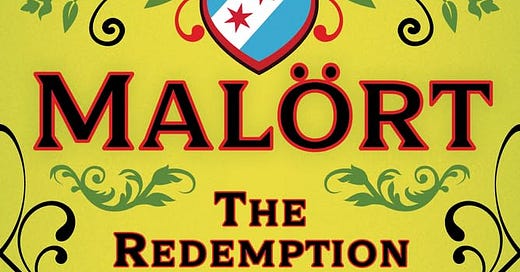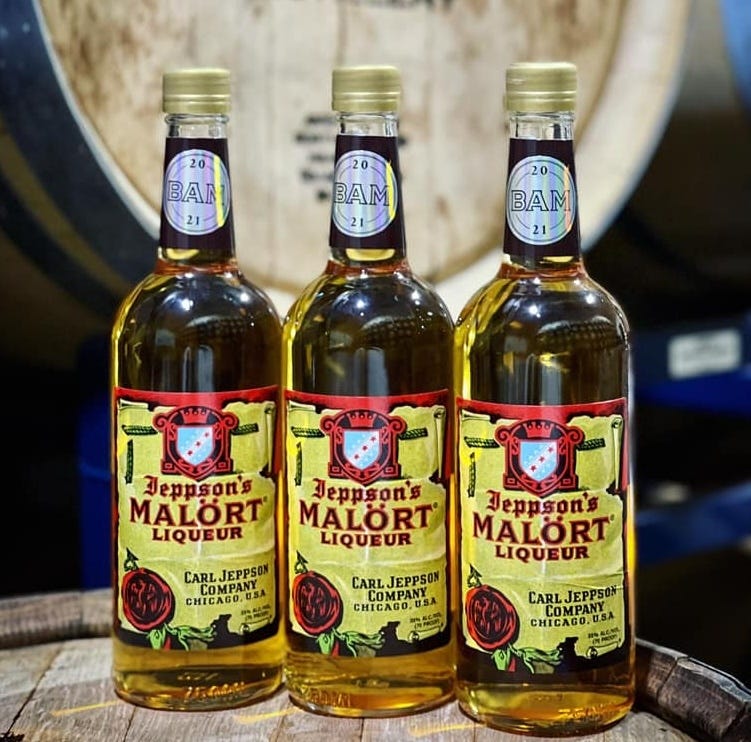This email won't make you sh** your pants
A chat the author who explored the insane story of Malört
Apologies for the crass subject line, but that’s in reference to a tagline seen in bars that serve today’s topic: Jeppson’s Malört.
If you’re unfamiliar, it’s an insanely bitter (many would say disgusting) liqueur local to Chicago that’s having a bit of a moment. Actually, it’s been having a lot of moments — like the recent New York Times piece, “The Rise of Malört, an Unexpected Midwest Princess,” and taken as shots on the Golden Bachelorette.
I chatted with Josh Noel, author of Malört: The Redemption of a Revered & Reviled Spirit. I’ve known Josh for a while now, a former Chicago Tribune writer, he also wrote heavily about the craft beer industry, including the book Barrel-Aged and Selling Out: Goose Island, Anheuser-Busch And How Craft Beer Became Big Business.
Malört is an acquired taste; one that people like Josh and myself have come to genuinely like. The first sip, though, brings a lot of goofy faces. It’s an experience and flavor that makes you say “Maybe I want that again.”
And the descriptors, some of which are quoted in Josh’s intro, are enough to go… hmm maybe I don’t want to try that:
“A forest fire, if the forest was made of earwax.”
“Burnt vinyl car-seat condensation.”
“Hairspray and death.”
“Akin to swallowing a burnt condom full of gas.”
But it’s become a staple of Chicago—and now Chicago transplants moving home across the country. It’s part of what is affectionately called the Chicago Handshake, a shot of Malört and a pint of Old Style.
As I said, it’s having a moment. First, Josh’s book — a fantastic read that chronicles the incredible story of how this spirit survived the 20th century and somehow exploded in the last 15 years or so.
And for some reason, it just keeps going. As Josh says, worried when he started the book during a Malört moment:
“It often feels it’s having its moment, then it keeps going and going. Things happen that put it back in the public consciousness. Drake posted about it; the DNC happened with JB Pritzker taking shots with other governors. It keeps having these moments, the NY Times, Golden Bachelorette. People never get tired of it, there’s nothing else like it.”
Writing a book at the right time
Josh Noel has, twice now, found the seemingly perfect time to release a book.
His first book, Barrel-Aged and Selling Out, came out just at the apex of the modern craft beer movement and the high valuations of breweries selling out to brewery conglomerates and private equity firms. Now, the industry has flatlined and, in many ways, lost its luster.
This fall, he released Malört, a book about a peculiar spirit that survived through decades of sales that most businesses would have shut down. But then, through the magic of relationships, a burst of local pride and changing tastebuds, Jeppson’s Malört has now exploded beyond the Chicago city limits into bars across the country.
Ads at bars say things like, “Malort, these pants aren’t going to sh** themselves,” “When you need to unfriend someone in person,” “Weeding out Chicago’s weak since 1934,” and “Tonight’s the night you fight your dad.”
So, why did Noel want to write a book about this spirit that no one should really love?
“I wrote about Malört for the Tribune, and it was clear it was a subject people were, I was, interested in,” Noel said. “I had this epiphany once — I was in my kitchen, I was having a shot, I drink it at home, I enjoy it — but I had an epiphany that people are fascinated by this stuff, and we don’t know a lot about it and what we do know raises as many questions as it answers.”
First, he set out to find out if there was a book-length narrative to the story of Malört. He wasn’t sure. It had been an extremely mysterious product. There was no website for years. There was no real knowledge of who was behind it — it was, for a long time, made in Florida, a strange thing for something you really could only find in Chicago.
But as he dug, he found the real story: the people. And sure enough — and I say this as someone who wrapped the book up in about a day — it’s a good one.
“What was really interesting is it wasn’t the product itself, it was the people and the relationships behind it, almost none of which was known publicly,” he said. “That’s what allowed this story to be so special. A good narrative has to have people and relationships, and once I realized I had this intersection of fascinating people, fascinating relationships, and an absurd product I knew I had the book.”
We won’t detail the people and the relationships, because the book is well worth reading. Instead, the focus can be on why, all of a sudden in the early 2010s, did Malört take off?
Well, it has a lot to do with the same things that caused beer to explode as well. It was a push against the commoditization that the United States turned to following World War II, where everything was the same on supermarket shelves, be it Wonder Bread or light lagers.
“It’s rooted in cultural change, there was a new generation thinking differently about how they eat and drink,” Noel said. “For a long time, we ate and drank pretty boringly. Then we started thinking differently about it with farmers’ markets, farm-to-table, Whole Foods, small batch, and local.
“Kale, no one ate kale in the 1990s. Now we eat it all over the place. That reflects this huge cultural shift that happened.”
For Malört, it was a spirit sitting dusty on bar shelves in Chicago. But it had an important working-class heritage in the Windy City, with authenticity and bitter, polarizing flavors that became attractive, Noel said.
“The power of Malört is it’s not just a liqueur; it’s an experience,” he said. “There’s no experience with a shot of vodka, it’s just a utility. But a shot of Malört, it’s a ritual and that’s the secret power of Malört, and it’s something they couldn’t have invented themselves, it just happened.”
Interesting reads of the week
Well, attendees at a climate summit in Azerbaijan are apparently drinking a beer from Singapore made with … recycled toilet water. It’s a really neat story on how it highlights the efforts to reclaim water in Singapore, a country with no major freshwater resources of its own. (NY Times)
The Wall Street Journal dove into the world of tailgating for early football games. “You’re forced into binge drinking your butt off,” Clemson fan Alex Brotherton told the WSJ. For noon games, he starts the day with a mimosa or a Jack and Coke around 8 a.m. “The spirit is willing, but the body is weak.”
Georgian (the country) winemakers are trying to break free of Russia — which is relying on their supply thanks to sanctions from the war in Ukraine — and move toward European and American markets. (NY Times)
I was at a bar the other day, and there was a super simple Bloody Mary - and it looked so good, and I almost ordered it, but it didn’t. A lot of times places try to do too much with things that should be super simple. That’s why I loved this piece from Food & Wine, “Please Can I Just Have a Regular Bloody Mary, Caesar Salad, or Lasagna and Not Your Fancied-Up Take On It?”
Remember when we chatted with Sammy Hagar about his tequila brand with Guy Fieri? Well, apparently someone stole 24,240 bottles of it. (NY Times)
What we’re drinking
Yesterday, I hosted a Q&A with The Long Drink co-founder Eres Manner at the Grand Rapids International Wine, Beer, and Food Festival. So, naturally, I had a Long Drink while chatting with him.
I really can’t get enough of the whiskies from Utah’s High West Distillery. Right now, there’s a bottle of the bourbon on my bar cart. But the Campfire is a very fun whiskey that would do well as a holiday gift.






